#Easy Unit Convert
Explore tagged Tumblr posts
Text
Easy Unit Convert

Easy Unit Convert, your ultimate online resource for all your conversion needs. We offer a user-friendly platform with a broad range of calculators and converters that make everyday calculations easy and hassle-free. Whether you need to convert length, weight, temperature, volume, or speed, we’ve got you covered. Easy Unit Convert is designed to deliver accurate results with just a few clicks, saving you valuable time and effort. Navigate the world of numbers with ease and confidence with Easy Unit Convert – your reliable partner in making conversions simpler, faster, and more reliable. Start converting now!
Visit Our Website
0 notes
Note
Hell yeah dude congrats on the mini human!!! If you’re craving chocolate chip cookies, brownies etc but don’t want to worry about a messy kitchen after, there’s a few ways to make single servings in a mug in the microwave and a few of them don’t use egg if you’re worried about things like salmonella and any other health concerns that come with not using a conventional oven. Also, if you REALLY want another layer of protection, heat treating flour can kill a lot of harmful stuff as well for extra peace of mind. Either spread a thin layer on a cooking sheet and bake at ≈150°C (converted from freedom units lol) for 10 minutes, or you can nuke a bowl of it in the microwave for 30 second intervals, stirring occasionally.
I know when my mom was having my sister years ago, she had to be careful about things that were normally okay before and my dad would take a couple extra precautions when cooking for us.
I’ve also seen packets of Betty Crocker mix in stores marketed as “(X) in a mug” (the blueberry muffins are my favorite personally)
They’re marketed as just “Mug Treats” and so far I’ve seen one with Hot Fudge Brownie, one with Soft Chocolate Chip Cookie, and another with Funfetti.
Whew, sorry for the yapping 😅 I just remembered you mentioned craving chocolate and sweets so I thought I’d share with the class in case you wanted baked goods quickly and without all the mess afterwards.
Congrats again on the pregnancy, and don’t let the bastards get you down👏 you’re doing awesome
THANK YOU this is godsent, omg🙏🏻😭💗
I'll share it for everyone who's also pregnant or just hungry for no reason🫡 this is amazing and easy (and I'm a great cook and baker! I love being in the kitchen) I made one a week ago and then I made 5 more (aka my own mom made them with/for me) and I said it was literally the best thing my taste buds have ever witnessed in that moment. it really hit the spot. we also threw some cherries from a jar in that bih and it's🤌🏻 chef kiss
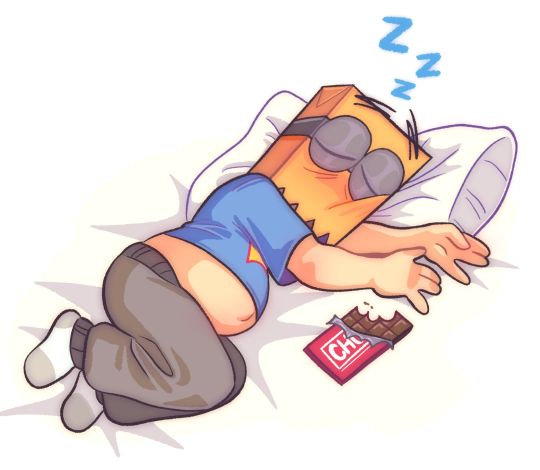
I should have put some empty mugs around him but this still conveys an accurate picture of what my past few weeks looked like
#love you for the no-egg recipes as I am allergic to eggs!#and a million other things! I rather list the things that my body won't violently reject than the things it will fight as if it's a virus#(I'm not as big; I barely show for some reason)#(which I'm kinda sad about)#(especially bc I feel super pregnant but I don't look like it at 30 weeks unless I wear smth tight or nothing)#but anyway I've been very tired!#no art; not online; just sleeping and eating and honestly chilling#we're almost done with the baby room and then I'll try to get a few more artworks out?#I'm gonna answer other asks soon#I miss a lot of them too bc I get spam-liked to hell here#thank youu again I'm always doing this now!!#villainous#villanos#dr flug#flug#kenning flugslys#vilanesco#villainous dr flug#mpreg#non kink mpreg#domestic mpreg#ask reply#anon ask#fanart#my art#“congrats on the mini human” is now my fav expression I need to remember that#did I mention how tired I am#I'm about to knock out as I write this
105 notes
·
View notes
Text
Gravity (Part 2)
This may be becoming a thing. There will be at least one more chapter and I have no idea what to call this thing. Maybe by the end I'll know. 😅
Gn reader x Raphael
Warnings: Hypothermia, language (but I think that's a given in a Raph fic?)
Part 1 Part 3

It had been one week. One week since he'd slipped. One week since the fever carried him to your rooftop.
You haven't spoken. More specifically, he hasn't spoken. Apart from texting you when he made it home like you insisted he did every night, it had been radio silence. You texted him before his patrol like you always did, and he stared at his phone, expressionless, before putting it back in his pocket.
What could he say?
He'd already had the conversation a thousand times in his head, and as far as he was concerned, it didn't need to be said. He didn't need you to let him down easy.
Because you'd mean it. Every damn word. You're sorry. He's your best friend. Nothing has to change.
But it would change, there was no way it couldn't. Things were different now.
That night had been the worst of it. He'd left not long after his confession. At that point, just the sound of your voice was enough to make him weep, and he didn't want to make things worse. Not that he thought they could *get* worse.
He made up some excuse about Leo calling it early, and ran.
He was running now, through the freezing rain, a sudden cold snap in the middle of spring, and hoping that between the temperature and the downpour hammering into his coat, he could think about anything else.
It wasn't long before he was considering ditching the coat. It was already soaked through, and weighing him down, which was hard to do.
That gave him pause.
He stopped, ducking under an overhang, and opened his coat, pulling the fabric back to expose his side. He twisted and looked at the small device mounted onto his shell just under his shoulder blade. There was supposed to be a little red light. There wasn't.
Shit.
They each had them. One of the first inventions D had come up with after they'd started doing patrols as kids.
A blizzard had suddenly torn through the city one night, and they were woefully unprepared with only winter coats. The cold dropped their body temperatures, and then them. Splinter had to hunt across the rooftops until he found them, asleep and hypothermic, huddled behind a construction dumpster.
Donnie didn't leave his lab for days. He blamed himself, he should have known the blizzard was coming, that their gear was insufficient, he should have had *some* kind of backup heat supply. No matter how many times his family told him otherwise, it was his fault, and he would never let it happen again.
So he built something to fix it. Raph didn't really get a lot of the specifics, but the overall was that the small devices "converted kinetic energy into heat that was then stored and distributed throughout the inside of their shells." Or, as Raph understands it, as long as you keep moving, you won't die.
One night a few weeks ago, someone had gotten lucky and he had taken a rusted rebar to the chest that had shattered on impact. His regulator had been damaged by the shrapnel, but the weather had already been warming up, and then the season hit and it was forgotten about.
The rain must have been the final nail, only the exterior was watertight. It was dead. He could already feel the cold and damp setting in. He needed to get home. Fast.
He set off, the only sound other than the roar of the rain was the gradually slowing heartbeat that pounded in his ears.
*Fuck* it was cold.
It wasn't long before his waterlogged coat became too much to carry. He ditched it behind an air conditioning unit, and kept moving.
Hailstones felt like bullets as they pelted bare skin, and through the sheets of rain, the haze of cold and exhaustion that had started at the edges was encroaching. It wasn't long before he was too tired to think.
He was moving on pure instinct, without even the presence of mind to pray he could make it somewhere safe. Somewhere in the back of his mind a tiny Leo was lecturing him for not hitting his emergency signal.
He stumbles. He is so, so tired. The soft darkness of sleep is pulling at him like a rip tide. He drags himself to the next rooftop, barely touching down before he collapses.
187 notes
·
View notes
Text
The height of WHB demons
A random thought that came to my mind after a conversation with a friend. Let's check how tall our hotties are. At first I thought about checking the height using sprite, because the kings are quite adequate to the descriptions. The only thing I would disagree with is Beel and Levi, but Levi leans over a bit, which may be why he seems shorter when they should be the same height.
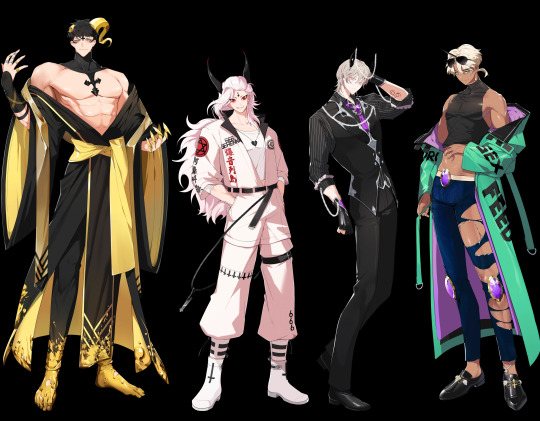
Satan you smol bean <;33
Then. I saw Foras and Bael's poses. Well, nothing from the foreground.
Funfact - the difference between Glasyal and Mammon sprites is the same as that between Mammon and Beel. Yes, Glasya is taller. Yes, I know that canonically he is probably the only devil the size of Mammon, but I changed my mind and went to compare them differently.
There will be very loose comparisons. This can't be done very reliably, but in the comics we can see here and there what they look like standing next to each other.
By the way! I hope I didn't confuse inch when converting them from cm, but I have no idea about imperial units. It won't be worse than Michael and his 38 cm anyway.
UPDATE: YEAH I DID CONFUSE IT LOL. Because it turned out that I had converted the units incorrectly (very sorry, my fault!), I'll just stick to cm for now. If I have time, maybe I will try to calculate it again.
Let's start with something smol easy - Satan - 178 cm.
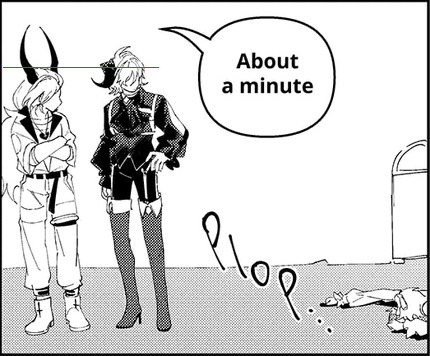
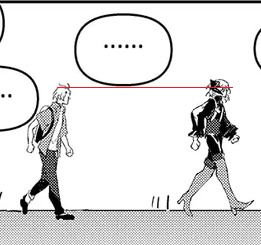
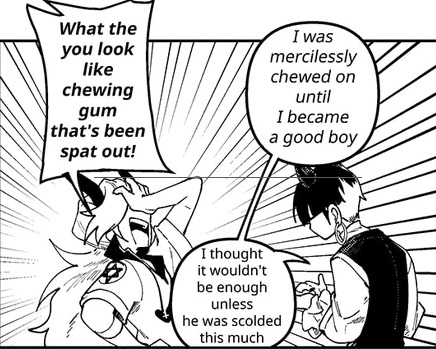
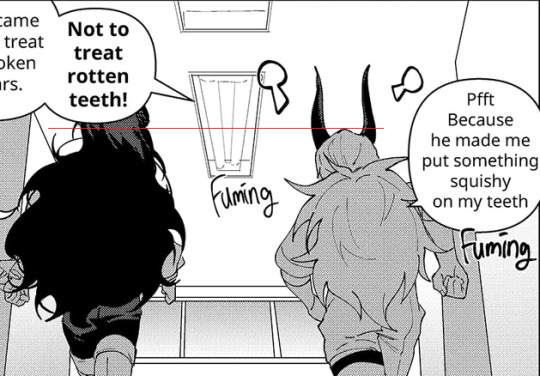
You know I'm obsessed with these two. This was the only time I counted the pixels (in Sitri's stupid heels) to know if he was taller than Satan without them. And yes. He is. (It's also possible that Sitri is tilting his head a little, but we got the general idea of them.)
It looks like Sitri is something between 180-183 cm. Compared to Sitri, Satan is high to the top of his horn, while Minhyeok is halfway up. So, Minhyeok should also be a little shorter than Satan (or his height).
It's a bit difficult with Belial, because he leans over, but it looks like he will be about half a head taller than Satan. Astaroth is a tower, no surprises.
Next, Beelzebub - 188 cm.
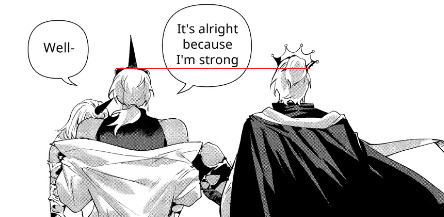
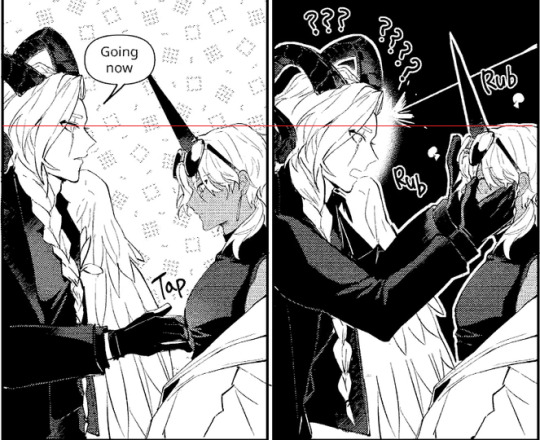
First, BAEL YOU'RE ???HIGHER??? THAN BEEL? So you're 190 cm tall AT LEAST? And he has no heels yes I checked!
And I thought I couldn't love you more, just give me a kiss. Andrea you can too-
Ekhm. So. Andrea is not a tower, but a whole skyscraper. And that's so hot of him. Unfortunately, either one or the other is leaning, so it's hard to judge, but Andrea should be about 200 cm. It actually fits, because from the description of the country it seems that the devils from Nilfheim are the most stature ones due to their rigorous military training. Glasyal, make room for your friend in the giants' team.
Another fun fact: Comparing the sprites, he's barely up to Mammon's (201 cm) chin. That's why I don't trust it.
Leviathan - 187 cm
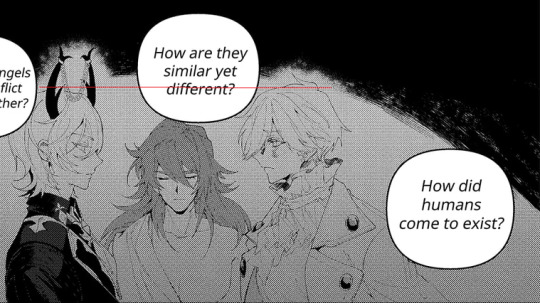

It looks like Levi and Gabriel are the same height, possibly Gabriel a little taller.
I know it's probably a perspective, but imagine that our extraordinary ancestor, a grand(x666)father who orphaned 80 demons and after which we have to clean up is actually small lol
In the second one, the perspective can also make a difference, but I chose it because it looks quite okay compared to Levi's other comics. (And you can definitely see them better than when they're rolling around on the floor.) Anyway, it's my dream that Foras would be a little shorter than Levi.
Update: Chapter 5 confirms that both Leviathan and Foras are of similar height when standing side by side.
Here he is, a Burj Khalifa of a man, Mammon - 201 cm
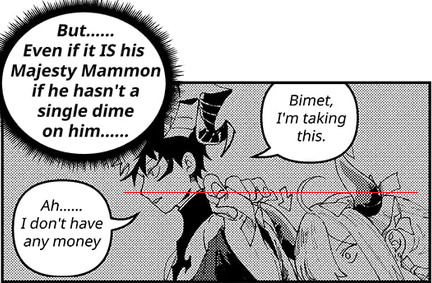
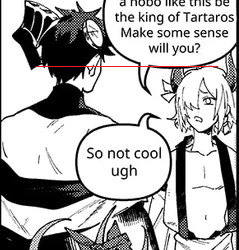
Like Levi, he doesn't know how to pose at all. That's why he is only with Bimet. In both of them, Bimet is more or less up to his shoulder, which is comparable to Satan, which gives us ~180 cm. I expected more from you, Bimet. Disappointing.
That's all I have compared to kings. But.
There are several devils that can be estimated from each other, but since we don't know how tall they are, we can only compare them. Let's do it, because why not.
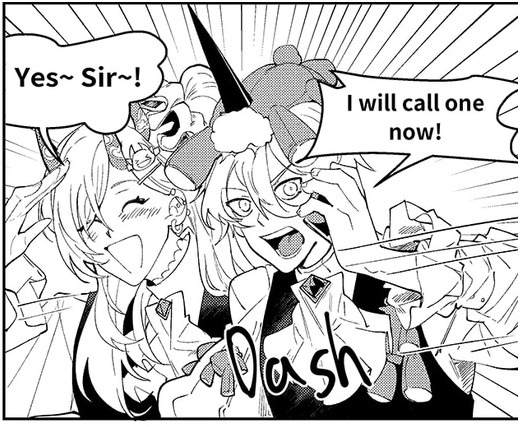
Paimon and Leraye - only one screenshot, but they will be of similar height. They can be seen together quite often. Here they can be seen simply most clearly in terms of height. (In one comic they are also next to each other, but there are different panels so the perspective may also differ.)
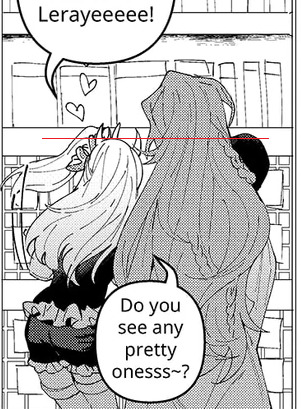
Of course Paimon is bending over here, but I put it in here rather following in the thought of the little grandpa. Impossible, because I doubt Paimon will be that small (still funny to imagine).
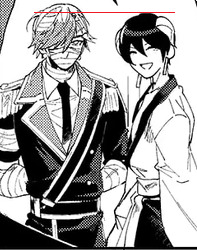
I didn't expect Morax to be so tall. Taller and better built than Buer. He looks so delicate in his sprite, but in the comics he's hot. (I had to cut off Marbas's legs to get Tumblr to let me post it. I recommend the entire panel.)
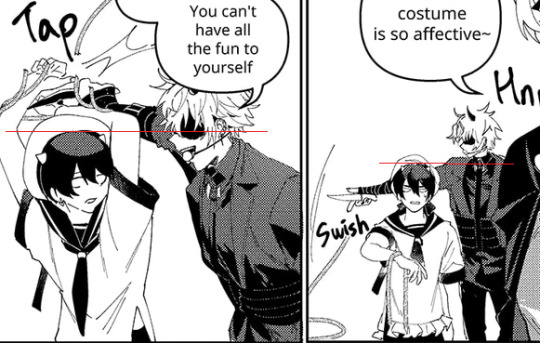
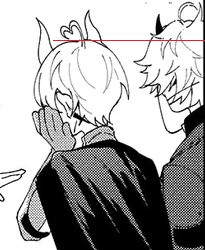
Another interesting thing. I fully agree that Ronove is much bigger than Dantalian. But for Phenix to be the simillar height as Ronove? Yes, the perspective here is not one to one, but I didn't expect Phenix to be quite high.
Phew! I think that's all I could glean, at least from things that looked somewhat legit. There was a lot. Congratulations if you made it to the end! I wonder how much of this will turn out to be true in the future.
#I did it in euphoria as I saw Bael's height#I'm yours here and now just take me#whb#what in hell is bad#whb beelzebub#whb satan#whb mammon#whb leviathan#whb theory
615 notes
·
View notes
Text
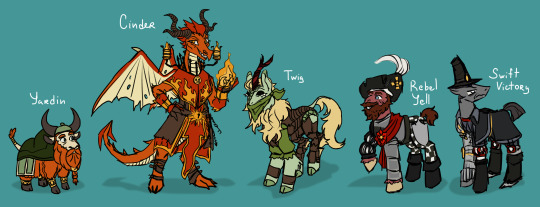
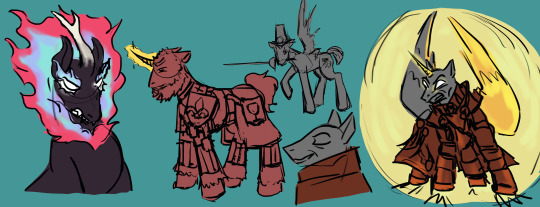

Friendship is magic - and magic is heresy!!
MLP crossover with the U5 (as well as other... horse media) more ramblings for my choices under the cut
Ok so first an foremost, Kruber and Saltzpyre are the only ponies in U5, because both are imperials and therefore represent a majority of pegasi and earth ponies (Think of Ponyville uniting with Cloudsdale - boom you get Reikland, so that Bretonia is basically Canterlot haha)((also did I warn you that these are completely unserious?)). Victor is a pegasus with a mauled/missing wing because I thought the skaven did so besides taking his eye, BUT also because of a coooler symbolism down the line: Sigmar is a deity, right? Deities or figures of power are alicorns in the mlp usually, right? So by loosing his flight dude wants to reconnect with his faith which he later does by being converted into Sigmar's prized fridge and he gets like a manifestation of magic through a horn and a pair of wings when he does his warrior priest thingie :oD (plus i only now realised that with his wings on such a display Victor really resembles a twin tailed comet). Kruber can be viewed both as an earth pony and a unicorn (but i like earthponyness more because i don't respect the grail knight career haha). If he is a unicorn, he just hides it under his absurd headwear, (because i think if we take into the account that he is some long descendant of mandelot then a unicorn being born on an earth pony farm sounds almost tragic, but would explain why he felt he didn't belong and left), and if he's a earth pony then it's easy - when he does get to be a grail knight, the lady just grants him a temporary "horn". So Markus and Victor somewhat match haha). As for the rest, there isn't much to say, because their races kinda say everything for themselves. Sienna is a dragon (Still near Reikland, just different nation, so with the dragons in MLP, they lived near Ponyville as far as I remember). Breathes fire, perhaps practices magics? Bardin is a Yak (Patriotic, hold grudges and live in mountains + have a lot of gold braces on their hooves/in their manes/beards), very different (and small) from his compatriots so no wonder he is here and not in Yakistan. And Kerillian is a kirin, because they have this society based on a vow of silence to not rustle emotional demons and shit, so by breaking this vow and going on a killing spree similar to the one, alluded to in the game's lore and dialogue, letting out her edgy fiery teen because of an augury, she was exiled. Plus kirins live in far away forest lands so wood elves it is haha. Thank you for coming to my ted talk. HRT horses are just for fun
#horse race tests#vermintide#vermintide 2#warhammer vermintide#my little pony#my litte pony friendship is magic#mlp#mlp crossover#ponyfication#victor saltzpyre#saltzpyre#markus kruber#kerillian#sienna fuegonasus#bardin goreksson#mlp yak#mlp kirin#mlp dragon#man i'm such a yapper#you can argue or agree with me i don't really mind#it was just a fun exercise in adapting something
47 notes
·
View notes
Text

1970 Dodge Challenger T/A
1970 Dodge Challenger T/A Sitting for 45 Years Is a Rare Barn Find in Sublime Green
Introduced in 1969 on the then-new E-body platform, the first-generation Dodge Challenger was a big hit, moving nearly 77,000 units in its first year on the market. And while it may seem rather common, the 1970 Challenger lineup included a few rare gems.
Nearly 73% of the cars were ordered in standard trim, leaving only 18,512 R/T models. Most of the latter left the assembly line with the 383-cubic-inch (6.3-liter) V8, and just 6,231 units were specified with the larger 440-cubic-inch (7.2-liter) RB and 426-cubic-inch (7.0-liter) HEMI mills.
The HEMI is arguably the rarest 1970 Challenger, with only 356 examples made. Just 60 were also ordered with the SE package, and only nine were convertibles. The 440 Six Pack version is also rare at 2,035 examples, while the regular four-barrel 440 found its way into 3,840 vehicles.
But Dodge also built a small-block gem that saw daylight in limited numbers. I'm talking about the Challenger T/A. Developed to homologate the Challenger for the SCCA Trans-Am series, the T/A was available for only a few months in 1970. And its short stint on the assembly line resulted in only 2,399 street-legal models being built and sold.
The T/A packs several unique features, including a low-restriction exhaust system with side-exiting pipes, a larger air scoop, a fiberglass hood, and a heavy-duty suspension. The stripe package is also unique to this car, as is the 340-cubic-inch (5.6-liter) V8 with a triple two-barrel carburetor setup.
An upgrade over the more common four-barrel 340, the Six Pack layout gave the T/A 290 horsepower to play with. And even though it's nowhere near as powerful as the big-block cars, the T/A has a solid advantage in terms of curb weight and handling.
Come 2023, the T/A is one of the most desirable versions of the 1970 Challenger. And while many cars are still around as restored gems, some are rotting away in junkyards and barns, often missing vital components. The Sublime green example you see here is one of them. But unlike other abandoned T/As, this survivor got a second chance at life, and it's roaming the streets again.
Documented by YouTube's "Auto Archaeology," this T/A spent most of its life off the road. According to our host, the Challenger was parked for unknown reasons sometime in 1977. So that's only seven years on the road and more than four decades in storage.
Parked with a four-barrel carburetor instead of the Six Pack setup, it remained in storage in Memphis and Arkansas until 2022. That's when the car was sold and dragged out of its barn. And surprisingly enough, the T/A emerged in surprisingly solid condition.
Sure, the Sublime paint has faded away, and the black vinyl top is long gone, but the body is straight and almost rust-free. There's some rust on the trunk floor, but it's an easy fix with a regular Challenger pan, which is relatively easy to find.
The engine bay was empty at the time of the rescue, but the car still had the original block. And even though the Six-Pack carb was gone, it came with a period correct unit. The driveshaft, air cleaner, automatic gearbox, and the original wheels (which are very rare) were still with the car.
Speaking of which, the automatic makes this T/A one of 1,410 vehicles built with this drivetrain combo. The vinyl top decreases that number even more. It's unclear if it came with a V1G gator grain top, but if it did, it's one of only 33 T/As built like this.
But the really good news about this Challenger is that it has since been revamped and put back on the road. It hasn't been restored just yet, but it's not a solid survivor that's no longer rotting away in a barn. And that's a win in my book.
#Dodge Challenger T/A#dodge challenger#dodge#challenger#T/A#car#cars#muscle car#american muscle#mopar#moparperformance#moparworld#moparnation#challengers
75 notes
·
View notes
Text
Businesses & Hobbies EP
I am happy about the new EP but if you take away the cross pack compatibility, it seems empty. However, I built all of those multi-purpose lots for my San Myshuno and I WILL finally make employees for each area.
San Myshuno Makeover Info (CC)
[NOTE: I do not own the pack yet. Since, they were all done before the EP announcement, none of them are assigned. However, everything should be easy to differentiate and they were all playtested.]
This is all a coincidence that I produced a whole bunch of multi-purpose lots. I do NOT work for EA and never have. Nor do I have ties to anyone to have known this was coming lmao
If you see me enter a giveaway… that's between me and the voices in my head LOL In all seriousness, I'll most likely buy it on sale if I don't win a giveaway. I'm not ashamed to say that I have never purchased Sims 4 DLC full price. I purchase things at the value that I see them being worth, exception being kits for the obvious reason. I only own 6 kits.
Planet Honey Pop!
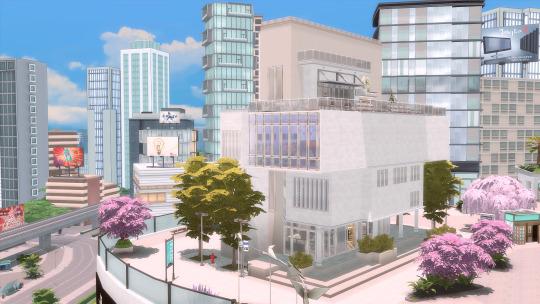
Arcade
BubbleTea & Thriftstore
Reading Area
Rooftop Bar
Internet Café
New York City: ONE
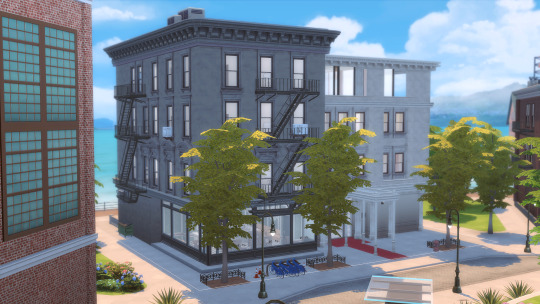
5 Residential Rentals
A Cafe
A Laundromat (not functional BUT 4 units have a washer/dryer)
A Game Room
New York City: TWO
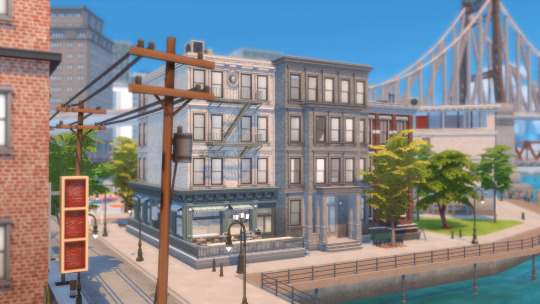
A Dive Bar
A Pizzeria
An Internet Café
A Tattoo Shop
6 Empty Residential Rental Units (Unassigned)
New York City: THREE
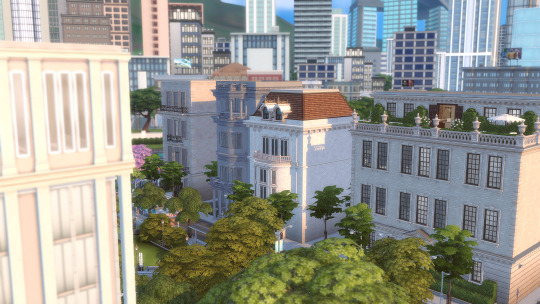
Hotel (5 Suites)
A Corner Store
A Hair Salon (with spa objects)
An Outdoor Concert Venue
Bonus: 4 empty shells to fill
1 Torrendi Tower

Bar
Bowling (4 Lanes)
BubbleTea Counter
Karaoke (4 Private Rooms + 1 Main Stage)
Outdoor Performance Area
Restaurant
The S Hotel @ Uptown
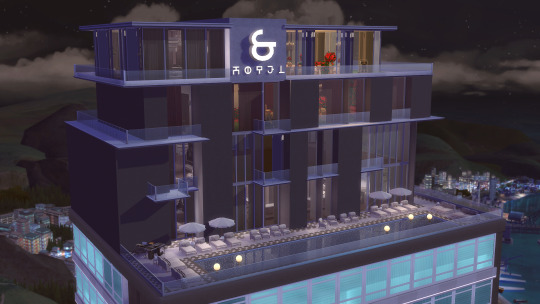
A Bar
An Empty Space (Can be converted to hotel rooms)
A Pool
A Restaurant
A Wedding Venue
A Wedding Reception Venue
Skye Wellness Center

A Boutique Shop
A Buffet Style Cafeteria (w/ Dining Area)
A Gym (w/ Locker Rooms)
A Pool
#simstorian#the sims 4#sims 4#ts4#ts4 simblr#san myshuno#businesses & hobbies#cc used#sims 4 commercial lot#showusyourbuilds#blacksimmer
60 notes
·
View notes
Text
The Hobie Brown Punk Playbook - Part 2. - What is Punk? (Punk 101)
A short series where I analyze the political, historical, musical, and romantic influences of Hobie Brown, and how it affects his arc, design, and character.
1) Anarchism 101 / 2) Punk 101 / 3) Hobie Characterization Guide (How to Write Hobie) /4) Punk & Hobie's Design / 5) Romance in the 70's __________________________________________________________
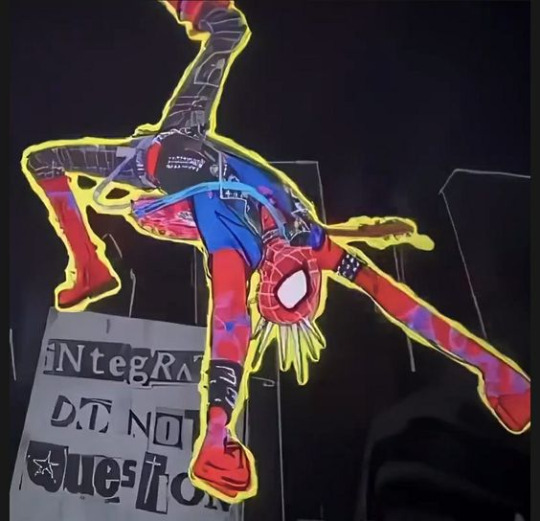

Clueless about punk? Know nothing about the 70's? Or wanna learn more? Start here! In the last part I examined Anarchy and what makes Hobie Anarchy personified. And next, I think it's only natural to turn my attention to the thing that makes Spider-punk - punk.
In this part I'm examining what punk is, why the movement was created, what punks believe, and what they stand against.
This is an analysis of Punk, 70's History, and why it makes Hobie who he is.

______________________________________________
Punk -
What is it? What 'makes' you a punk? And should Punk be Gatekept?
Punk can be hard to define - and that's by design. With the whole 'hates labels' thing considered, it's understandable. It may be easy to feel like punk as a concept is confusing, or daunting to even grasp.
But remember, Punk is made for the people - and it's made to be accessible and understandable to all people, of every class and ability - so I hope I can help!
Punk as a Subculture What is a sub-culture? Is a sub-culture the same as an aesthetic?
Punk is a 'sub-culture' - a specific type often called a 'counter-culture'.
In basic terms, a subculture is a lifestyle.
Goths, Punks, Vegans, Nudists, Surfers and even things like the LGBTQ+ community are considered subcultures.
Subcultures effect many things such as they way you dress or your taste in music, and your hobbies. But subcultures can also effect things like your morals, political affiliation, identity, behaviors, and the spaces you exist in.
Subcultures are usually based around morals (Veganism, Punk, Straight Edge.), hobbies (Surfers, Stoners, Ravers), or identities (LGBTQ+ and African-American culture). By engaging in activities, a manner of dress, or a patter on behavior in a subculture, it becomes is way to outwardly express your beliefs and feelings - while also connecting with people who feel the same.
For example - Although Surfers are united through a hobby in specific, it'd be safe to assume that a surfer would, naturally, be pro-conservation, pro-animal rights, and anti-pollution. A surfer that promotes ocean trash dumping seems weird, right? That's because the surfer subculture has a political identity defined by the movement's past. Although a surfer surfs - what makes them a 'surfer' as a opposed to 'someone who surfs' is their participation in a culture that includes other things besides surfing, such as music, dress, and even the way they live - like choosing to live beach side or convert to vanlife, choosing to live off very little, etc. They may do some or all of those things, but all their core, what makes them a 'surfer' is their hobby, beliefs, and dedication.
The same way the Surfer 'Lifestyle' is more than just surfing, the Punk 'Lifestyle' is more than just music.
Punk is a subculture, a counterculture specifically. But what does that mean?
What's a counter-culture?
A counterculture is a subculture that arises to directly challenge a societal norm.
Not all subcultures are countercultures; but a lot are.
For example - Drag-racing is a subculture that exists around a hobby. By racing they are engaging in a subculture, but they're not directly trying to challenge society. Whereas on the other hand - Someone who is Straight Edge is consciously choosing not to drink - and consciously choosing to identify as straight edge in addition the being sober - in order to challenge societal norms and behaviors around drinking and drugs.
Most counter-cultures arise in response to a political event or social development.
Is a subculture and an aesthetic the same thing?
No. Subcultures and Aesthetics differ in one way -
A subculture displays and effects identity. An aesthetic does not.
What I mean is - a subculture effects your beliefs, thinking, behaviors or political alignment. An aesthetic does not.
For example - Hippy is a subculture because it encompasses a thought system. When you see a hippy - its safe to assume that they are anti-war and liberal. A 'republican hippy' seems absurd, because inherently, there is a moral and political align attached to the movement. Whereas on the otherhand - Emo is an aesthetic because it does not encompass a thought system - It is has no moral or political attachments. Although it includes a manor of dress and music the same way hippie may - it lacks moral implication. Because of that 'republican emo' is not contradictory - whereas a 'republican hippy' is.
Because of this, it usually makes no sense to judge someone based on their aesthetic. On the other hand, as the fashion, music, and style go hand in hand with it's politics, it's safe to assume and judge aspects of someone based on their subculture or counterculture. Punk is a counterculture - so it inherently has moral connotations - tied directly to the historical events the influenced it.
While someone being emo may not tell you much about who they are as a person, Hobie being a punk can tell us a lot about who he is!
[I talk more about Punk, subcultures, and aesthetics here.]
Now that we understand countercultures and their function, let's look at punk in specific.
Punk - Basic Roots & Definition
By objective definition:
Punk is a counterculture that developed around the 1970's primarily in the cities of London and New York. Made up of almost exclusively of lower- and working-class folks of all ages - the movement grew in response to a couple of different political events throughout the 70's, all of which shaped the message and lifestyle that would become punk. Mainly centered around government corruption, surveillance, and anti-communism in the Western World, these events inspired a movement of anti-government, anti-war, anti-surveillance, and anti-capitalism.
With World War 2 ending in 1945, the world was left in a world divided between capitalism and communism.
With the start of The Vietnam war in 1955 (don't fret, I'll explain), average people were growing tired of the seemingly endless wars, and the corrupted, secretive governments that commanded them.
This gave way to the hippy movement - an anti-war counterculture centered around radical peace and pacifism. But as the Vietnam War stretch through the 60's and into the 70's, the hippy movement and it's pacifism waned.
As the CIA began to squash protests, and Western governments engaged in more corruption and espionage - the pacifism turned to anger, and the outcry turned to music.
What came next was Punk.
Now that we understand the roots of Punk - let's do a quick run down of the historical events that influenced it, and the beliefs that arised from it.
Before we begin, keep in mind that these are all events that Hobie would live through - and have opinions about. Born somewhere between 1958 and 1961, and living in 1978 (according to his intro mugshot) - all of these things would have an effect on Hobie, the way he was raised, and the struggles he had to face.
All of them have a really cool influence on Hobie and the punk movement, so let's take a look -
1978 Punk - Basic Historical Events & Beliefs
The Vietnam War (1955 - 1975) - A war between the Communist North Vietnam and Capitalist South Vietnam. In order to ensure the spread of Capitalism, the United States government crossed the globe into foreign borders in an attempt to secure victory for North Vietnam. They committed a LOT of atrocities that still effect the Vietnamese people to this day. In addition, The US government participated in drafting during this time. Eventually, the Communist Resistance proved victorious, and the country of Vietnam is currently communist. Resulting Punk Belief - Anti-Capitalism, Anti-War, Anti-Colonialism, Anti-Draft, Pro-Communism, Pro-Armed Resistance (in response to North Vietnam's armed victory.)
The Rise of Margaret Thatcher (1975-2013) - Often called the most hated woman in all of Ireland and probably the UK too, Margaret Thatcher is one of the most influential British Prime Ministers of all time. Leader of the 'Tories' (Short for Conservative) since 1975, Margaret Thatcher took office in 1979. Which means in 1978 - when Hobie is - she would currently be running her campaign for Prime Minister. Margaret Thatcher largely contributed to the unrest and conflict within the British-occupied Northern Ireland, as well as hardship within the working-class in her own country. Even though she left office in 1990, it can easily be said her damage lasted until the day she died, and even beyond. When Hobie says he hates the PM. He without a doubt means her. Resulting Punk Belief - Anti-Government, Anti-Conservative, Anti-Colonialism, Pro-Armed Resistance (in response to the Irish Republican Army)
The Civil Rights Movement - It can be hard to believe that Hobie's life overlaps with that of the Civil Rights Movement - but it does! With Malcom X's assassination in 1965, MLK's assassination in 1968, and Fred Hampton's (Black Panther Party) assassination in 1969 - regardless of how you age him - Hobie's childhood was largely characterized by the death of many Civil Rights Leaders in America. Even despite being British himself, Hobie would directly face this for much of his childhood - as racial segregation was legal within the UK until 1965 (around the time he'd be 4-7, if you age him 17-20). However this era was also characterized by the rise of Black culture in media, whether it be Disco, Ballroom, The Black Panther Party or Blaxploitation Movies. Resulting Punk Belief - Starch Anti-Racism, Extreme Race Solidarity, Affirmative Action, Black Pride
Queer Liberation Wave 1 (1969-1979 and onward) - After spending years as an oppressed, underground subculture Queer Identity and it's liberation came to limelight throughout the 70's. The 70's began and ended with two of the most important events in Queer History - The Stonewall Riots and The White Night Riots. In 1969, New York City police officers raided and brutalized patrons at a popular pub called 'Stonewall'. Many trans people as well as a number of drag performers were being arrested for cross-dressing, which was illegal at the time. Stormé DeLarverie - a mixed-race drag king and butch lesbian, called out in anger and desperation at a crowd of onlookers, which incited the riot that is known as the beginnings of the Queer Liberation Movement. Stonewall Inn still exists until this day - and a year after it's anniversary - the first ever pride parade was started in NYC. Ten years later in 1979, a man named Harvey Milk was running for office in California. An openly-gay man and activist, Harvey was assassinated by a man named Dan White. When Dan was only lightly sentenced for this however, 100k people marched for Harvey's justice - sparking a night of violence and direct conflict with the police. Resulting Punk Belief - Anti-Police, Anti-Justice System, Anti-Bigotry, Anti-Homophobia, Queer Liberation
Other notable historical mentions that are just as important but probably too complicated and/or boring for me to talk about:The Cold War (1945 - forever probably) - The on-going and ever-evolving power struggle between Capitalism and Communism, The West and The East, and nuclear warfare. Yay. Particularly heated due to the Vietnam War, and conflicts in the Middle East. The Watergate Scandal and the Nixon tapes (1972) - The Nixon administration gets caught wiretapping an opponent's office. Nixon is caught on tape trying to cover this up. Tapes are leaked. Nixons resigns. The War on Drugs (1971 - forever probably) - The Nixon administration ignites 'The War on Drugs', a campaign for strict criminalization of drug use. Although a ploy to 'clean up streets' it's backwards logic actually led to more extreme drug conditions. In addition, it also overlapped with the CIA distributing cocaine and crack into Black communities in the 1980's so.... yeah the drugs won the war.
So, What does any of this have to do with Hobie Brown?
And Can Hobie be written better?
Now that we have a better understanding of the world that raised Hobie, when we look back at him, we can get a lot clearer view of who he is and what he probably believes.
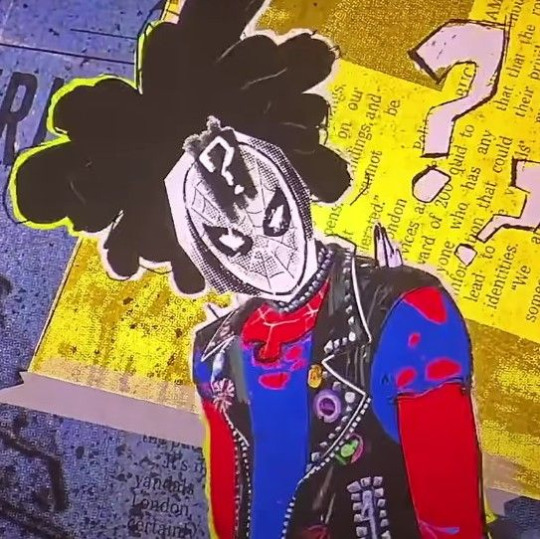
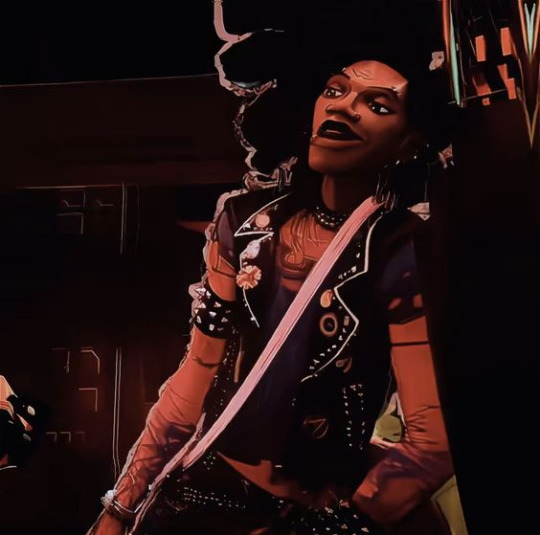
[And if you need a second to look at him after reading this far I completely understand I do too here ya go]
With all that in mind, we can say:
Being born somewhere between 1959 and 1962, Hobie Brown is a black guy raised in an era of persistent conflict, growing conservatism, and on-going social change. His existence is resistance in and of itself.
History-wise:

Raised in the 60's and coming-of-age in the late 70's - Hobie's life has probably been characterized by persistent war, and a generation who met it with radical kindness and compassion.
Although Hobie is a punk himself, Punks and Hippies have roots in the same places and concerns - albeit it different approaches. But at their cores, they're about freedom - and compassion towards others who need it most.
Hippies centered their movement around kindness and non-violence, but also action through resilience, community, and peaceful protest. And Hobie may not believe in non-violence (which - he doesn't. He believes in violence let's be clear.) we can still see the influence of Hippies on his upbringing and behavior.
Throughout ATSV, Hobie's action are motivated and based on resilience within the face of an oppressive institution, and his actions of protests are direct ones - they're indirect, such as building community between him, Miles, and Gwen. His methodology is one of gaining intelligence and destabilizing from the inside.
Race-wise:
To put it blatantly, as this something I feel like isn't highlighted about his character enough-
Hobie would have direct and real experience and trauma around his race based on the time he's from.
And without a doubt, his race would be something he has a lot of pride in.
Hobie would be very vocally proud to be black.
For once, Hobie without a doubt would be raised in a time where racial discrimination and segregation was legal for the beginning of his childhood. He's raised by black people who have lived with this segregation and abuse for all of their lives. And despite the illegalization of segregation in 1965, many racist attitudes would still persist to his modern year.
But, this is Hobie we're talking about. Hobie also was raised in a time where pride in a black identity was stressed at every turn. He's a black guy in 1978. He has wicks. Those two things connect.

When you see his leather vest, your first thought may connect to Sex Pistols, or UK punks. But Black Panthers - a movement that existed all throughout his life, wore leather jackets just the same.
I believe the Panthers influence Hobie a lot too. Many know the Panthers for their direct conflict with police - and Assata Shakur (Tupac's Aunt) being a member.
But the Panthers were also ALL about community. In fact, they started a program to feed inner-city kids breakfast and lunch throughout summer. Many are still going across the country. {As a child, this program fed me and my schoolmates :) }
Hobie takes after them. He sees a younger black child in need of help, and he takes a break from fighting to help them, mentor them, and teach them about the cause. Hobie would absolutely have a Black Panther pin on his jacket!
This is something that is really just brushed over in fanfic and fandom and I'm hoping to write a piece about how to better characterize him because of this - but from here, let's keep this in mind!
Political-wise:
Hobie lived in a time of extreme change, progress, and political development. And to some, his methods may see just as extreme.
But now that we have a context for who he is and who he exists as, lets me transparent about it.
Growing up post-Hippy era, during the rise of conservatism in Britain - as a low-classer class black kid - Hobie's attitude towards activism would differ than those before him.
As most of the adult population seemed numb to war, and most of the Hippy subculture disbanded, outward rebellion and resistance would look a lot more pro-active in many ways, but just as thoughtful.
Hobie is very clearly an anarchist, but considering the political sphere of communism during the time as his behavior towards Miles and Gwen - I do believe he'd support communism, with anarchy being his primary stance and focus.
I honestly believe that Hobie would be pro-armed resistance. As Northern Vietnam and the IRA defended their homelands from foreign invasion, and the Black Panthers armed themself with guns against brutal police forces - Hobie's life would be colored with resistance through armed means.
Hobie uses his guitar as a weapon, both musically and physically, and he carries it openly. He doesn't need to do this. He's Spider-man. He choses to do this. I think Hobie would approve of the oppressed arming themselves, and that's why he does it himself.
And of course, he's anti-police or any form of military, militia, what have you. They are the arm of the state and exist only to target civilians with their will. I believe he would have no sympathy for police - as actual punks in his era had no sympathy for police. [And if he did (he doesn't) he'd be directly shunned by every other punk for doing so, because wtf.] But out of respect for the actual punks who inspired him, the Black activists brutalized, the queer people targeted, and all those who suffered under oppressive policing during this era (many of which are still alive and maybe even our parents), lets all agree Hobie outwardly and vocally hates police.
For many reasons. Many reasons personal and influenced by direct experience with him, or people he cares deeply about.
Please keep that in mind. It's quite literally impossible for Hobie to not be affected by these events to some extent.
Personality-wise:
This will be expanded in the next part - and of course this is just my opinion, but personality-wise, I think: Hobie is very politically educated and dedicated. And I feel like this is another thing that isn't highlighted enough or shown enough in fandom.
Hobie's morals, behavior, and methodology doesn't come from nowhere - and although they may be expressed in the music he listens to, the music itself is not the source.
It comes from direct experience with political action outside of being Spider-man.
Based on his deep understanding of anarchy and punk, we can guess that Hobie's very well-read, particularly in history and social theory. Both the IRA and North Vietnam were Marxist-Leninist, so it wouldn't be far of a leap to say that Hobie could be anarcho-communist.
Hobie would absolutely take the time to read - things like the Communist Manifesto, the Black Panther literature and other things.
In my opinion, from all of this - I can only assume Hobie is a reader, an avid one. He without a doubt participates in direct action outside of being SM - such as attending an anarchist/communist union, attending protests out of costume, organizing and planning meetings with other leftists, collecting and gathering supplies and food for those in need, squatting and securing housing for the homeless, and a lot of other things punks that aren't Spider-man do.
It kinda wouldn't make sense for him not to. He was a punk before he was Spider-man. When Hobie isn't being Spider-punk, and he's being a normal punk - if we try to consider how he spends his free time, a lot of the time our instinct is to imagine him and band. And that's a large part of Hobie.
But all of this is too. These are all things Hobie enjoys, because Hobie enjoys helping people. When Miles breaks free from the society, he's happy for him. It's all he wants.
_____________________________
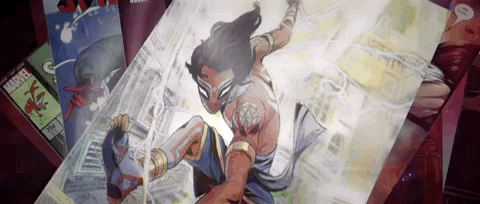
When we genuinely put Hobie into these scenarios, it really helps to humanize him. We can all see the depth in his character, and that depth comes from a real, genuine place.
Like a punk opposing the draft, Hobie opposes the oppressive leader that mandates the trauma of youth. Like a Black Panther with their afro, Hobie wears his hair with pride.
All of these events contribute to him and who he is, and he shows it with everything he does and chooses to be.
I hope understanding these events helps you understand Hobie and his motives more - and I hoped this post helped you understand the history of punk more!
-------------------------------------------------------
This is UNGODLY long - and ungodly wordy. But if you read this far, thank you! And I hope it helped at all! If you learned anything or have any questions, please let me know! I'd love to hear your thoughts, insights, revelations, etc. As you can probably tell I love rambling about Hobie and I'm totally normal and functional and not at all obsessed.
Please stick thoughts of Hobie Brown in my enclosure. I promise I'm normal about him. Thanks again!
#honey wake up its 12am and a new analysis just dropped#let me know if you read till the end!#this SPENT me i hope this makes sense#hobie brown#spiderpunk#spider punk#atsv#across the spiderverse#across the spider verse#spiderman#spider man#miles morales#gwen stacy#atsv analysis#marvel#itsv#hobart brown#Hobie Brown Punk Playbook
651 notes
·
View notes
Text
When Native Americans Were Slaughtered in the Name of ‘Civilization’
By the close of the Indian Wars in the late 19th century, fewer than 238,000 Indigenous people remained of the estimated 5 million-plus living in North America before European contact.On a cool May day in 1758, a 10-year girl with red hair and freckles was caring for her neighbor’s children in rural western Pennsylvania. In a few moments, Mary Campbell’s life changed forever when Delaware Indians kidnapped her and absorbed her into their community for the next six years. She was among the first of some 200 known cases of white captives, many of whom became pawns in an ongoing power struggle that included European powers, American colonists and Indigenous peoples straining to maintain their population, their land and way of life.While Mary was ultimately returned to her white family—and some evidence points to her having lived happily with her adopted Indian tribe—stories such as hers became a cautionary tale among white settlers, stoking fear of “savage” Indians and creating a paranoia that escalated into all-out Indian hating.From the time Europeans arrived on American shores, the frontier—the edge territory between white man’s civilization and the untamed natural world—became a shared space of vast, clashing differences that led the U.S. government to authorize over 1,500 wars, attacks and raids on Indians, the most of any country in the world against its Indigenous people. By the close of the Indian Wars in the late 19th century, fewer than 238,000 Indigenous people remained, a sharp decline from the estimated 5 million to 15 million living in North America when Columbus arrived in 1492.The reasons for this racial genocide were multi-layered. Settlers, most of whom had been barred from inheriting property in Europe, arrived on American shores hungry for Indian land—and the abundant natural resources that came with it. Indians’ collusion with the British during the American Revolution and the War of 1812 exacerbated American hostility and suspicion toward them.Even more fundamentally, Indigenous people were just too different: Their skin was dark. Their languages were foreign. And their world views and spiritual beliefs were beyond most white men’s comprehension. To settlers fearful that a loved one might become the next Mary Campbell, all this stoked racial hatred and paranoia, making it easy to paint Indigenous peoples as pagan savages who must be killed in the name of civilization and Christianity.Below, some of the most aggressive acts of genocide taken against Indigenous Americans:The Gnadenhutten MassacreIn 1782, a group of militiamen from Pennsylvania killed 96 Christianized Delaware Indians, illustrating the growing contempt for native people. Captain David Williamson ordered the converted Delawares, who had been blamed for attacks on white settlements, to go to the cooper shop two at a time, where militiamen beat them to death with wooden mallets and hatchets.Ironically, the Delawares were the first Native Americans to capture a white settler and the first to sign a U.S.-Indian treaty four years earlier—one that set the precedent for 374 treaties over the next 100 years. Often employing the common phrase “peace and friendship,” 229 of these agreements led to tribal lands being ceded to a rapidly expanding United States.
45 notes
·
View notes
Text
When Native Americans Were Slaughtered in the Name of ‘Civilization’
By the close of the Indian Wars in the late 19th century, fewer than 238,000 Indigenous people remained of the estimated 5 million-plus living in North America before European contact.On a cool May day in 1758, a 10-year girl with red hair and freckles was caring for her neighbor’s children in rural western Pennsylvania. In a few moments, Mary Campbell’s life changed forever when Delaware Indians kidnapped her and absorbed her into their community for the next six years. She was among the first of some 200 known cases of white captives, many of whom became pawns in an ongoing power struggle that included European powers, American colonists and Indigenous peoples straining to maintain their population, their land and way of life.While Mary was ultimately returned to her white family—and some evidence points to her having lived happily with her adopted Indian tribe—stories such as hers became a cautionary tale among white settlers, stoking fear of “savage” Indians and creating a paranoia that escalated into all-out Indian hating.From the time Europeans arrived on American shores, the frontier—the edge territory between white man’s civilization and the untamed natural world—became a shared space of vast, clashing differences that led the U.S. government to authorize over 1,500 wars, attacks and raids on Indians, the most of any country in the world against its Indigenous people. By the close of the Indian Wars in the late 19th century, fewer than 238,000 Indigenous people remained, a sharp decline from the estimated 5 million to 15 million living in North America when Columbus arrived in 1492.The reasons for this racial genocide were multi-layered. Settlers, most of whom had been barred from inheriting property in Europe, arrived on American shores hungry for Indian land—and the abundant natural resources that came with it. Indians’ collusion with the British during the American Revolution and the War of 1812 exacerbated American hostility and suspicion toward them.Even more fundamentally, Indigenous people were just too different: Their skin was dark. Their languages were foreign. And their world views and spiritual beliefs were beyond most white men’s comprehension. To settlers fearful that a loved one might become the next Mary Campbell, all this stoked racial hatred and paranoia, making it easy to paint Indigenous peoples as pagan savages who must be killed in the name of civilization and Christianity.Below, some of the most aggressive acts of genocide taken against Indigenous Americans:The Gnadenhutten MassacreIn 1782, a group of militiamen from Pennsylvania killed 96 Christianized Delaware Indians, illustrating the growing contempt for native people. Captain David Williamson ordered the converted Delawares, who had been blamed for attacks on white settlements, to go to the cooper shop two at a time, where militiamen beat them to death with wooden mallets and hatchets.Ironically, the Delawares were the first Native Americans to capture a white settler and the first to sign a U.S.-Indian treaty four years earlier—one that set the precedent for 374 treaties over the next 100 years. Often employing the common phrase “peace and friendship,” 229 of these agreements led to tribal lands being ceded to a rapidly expanding United States.
45 notes
·
View notes
Text
The Basics of Measurement Systems: Imperial and Metric

Before going further, it’s essential to understand the two primary measurement systems: imperial and metric.
The imperial system, primarily used in the United States, includes units like inches, feet, and pounds.
In contrast, the metric system is a decimal-based system used worldwide, with units like meters for length and kilograms for mass.
Alternative Conversion Methods and Tools While the mathematical formula is a reliable method for converting inches to centimeters, there are alternative tools and techniques available:
Online conversion tools: Numerous websites provide instant conversions for various units of measurement. Smartphone apps: Many apps, available for both iOS and Android devices, offer convenient measurement conversion features. Quick mental estimation: For rough conversions, you can divide the inches by 0.4 or multiply the centimeters by 0.4.
The Importance of Accurate Conversions Accurate conversions are essential for ensuring consistency and precision in various situations, such as:
Home improvement and interior design projects: Precise measurements are critical when working with furniture, appliances, and room dimensions. Clothing and shoe sizing: Proper conversions can help you find the correct sizes when shopping internationally. International shipping and packaging: Abiding by global regulations often requires converting measurements to different units, ensuring packages meet size and weight requirements. Manufacturing and engineering: Accurate conversions are crucial for designing and producing products that meet international standards. Scientific research and data analysis: Consistent measurements are vital for comparing data and drawing conclusions across various studies and disciplines.
Frequently asked Questions (FAQ) What is the purpose of an Inches to CM converter?
An Inches to CM converter serves as a convenient tool for accurately converting measurements from inches to centimeters. This is useful in many practical situations, from clothing sizes to architectural plans.
How does the Inches to CM converter work? The converter applies the conversion factor between inches and centimeters – 1 inch equals 2.54 centimeters. You input the measurement in inches, and the tool provides the equivalent value in centimeters.
Can I use the Inches to CM converter for fractional measurements? Absolutely! Our Inches to CM converter can handle both whole numbers and fractions, providing precise conversions for all your measurement needs.
Do I need to download any software to use this converter? No, our Inches to CM converter is an online tool and doesn’t require any download. You can use it anytime and anywhere you have internet access.
Why is it essential to know the conversion from inches to centimeters?
Knowing how to convert inches to centimeters is critical in a globalized world. Different regions use different measurement systems, and this knowledge can be handy in various situations, from understanding product dimensions to communicating measurements internationally.
Is the Inches to CM converter free to use? Yes, our Inches to CM converter is completely free to use. It’s designed to provide quick, accurate conversions without any cost.
Can I use the Inches to CM converter for professional projects?
Certainly! Our Inches to CM converter is accurate and reliable, making it suitable for both personal and professional applications. From design projects to engineering plans, you can trust our tool for precise conversions.
Conclusion Mastering the inches to cm conversion formula is an invaluable skill in today’s interconnected world. By following our step-by-step guide and understanding the significance of accurate conversions, you can confidently tackle any situation that requires converting measurements between imperial and metric units.
Remember to consider alternative tools and techniques for added convenience, and always prioritize precision when dealing with measurements to ensure the best possible outcomes in your projects and endeavors. With our user-friendly inches to centimeters calculator, converting measurements has never been easier.
ORIGINALLY FOUND ON- Source: Easy Unit Convert(https://easyunitconvert.com/inches-to-cm/)

1 note
·
View note
Text
When Native Americans Were Slaughtered in the Name of ‘Civilization’
By the close of the Indian Wars in the late 19th century, fewer than 238,000 Indigenous people remained of the estimated 5 million-plus living in North America before European contact.On a cool May day in 1758, a 10-year girl with red hair and freckles was caring for her neighbor’s children in rural western Pennsylvania. In a few moments, Mary Campbell’s life changed forever when Delaware Indians kidnapped her and absorbed her into their community for the next six years. She was among the first of some 200 known cases of white captives, many of whom became pawns in an ongoing power struggle that included European powers, American colonists and Indigenous peoples straining to maintain their population, their land and way of life.While Mary was ultimately returned to her white family—and some evidence points to her having lived happily with her adopted Indian tribe—stories such as hers became a cautionary tale among white settlers, stoking fear of “savage” Indians and creating a paranoia that escalated into all-out Indian hating.From the time Europeans arrived on American shores, the frontier—the edge territory between white man’s civilization and the untamed natural world—became a shared space of vast, clashing differences that led the U.S. government to authorize over 1,500 wars, attacks and raids on Indians, the most of any country in the world against its Indigenous people. By the close of the Indian Wars in the late 19th century, fewer than 238,000 Indigenous people remained, a sharp decline from the estimated 5 million to 15 million living in North America when Columbus arrived in 1492.The reasons for this racial genocide were multi-layered. Settlers, most of whom had been barred from inheriting property in Europe, arrived on American shores hungry for Indian land—and the abundant natural resources that came with it. Indians’ collusion with the British during the American Revolution and the War of 1812 exacerbated American hostility and suspicion toward them.Even more fundamentally, Indigenous people were just too different: Their skin was dark. Their languages were foreign. And their world views and spiritual beliefs were beyond most white men’s comprehension. To settlers fearful that a loved one might become the next Mary Campbell, all this stoked racial hatred and paranoia, making it easy to paint Indigenous peoples as pagan savages who must be killed in the name of civilization and Christianity.Below, some of the most aggressive acts of genocide taken against Indigenous Americans:The Gnadenhutten MassacreIn 1782, a group of militiamen from Pennsylvania killed 96 Christianized Delaware Indians, illustrating the growing contempt for native people. Captain David Williamson ordered the converted Delawares, who had been blamed for attacks on white settlements, to go to the cooper shop two at a time, where militiamen beat them to death with wooden mallets and hatchets.Ironically, the Delawares were the first Native Americans to capture a white settler and the first to sign a U.S.-Indian treaty four years earlier—one that set the precedent for 374 treaties over the next 100 years. Often employing the common phrase “peace and friendship,” 229 of these agreements led to tribal lands being ceded to a rapidly expanding United States.
45 notes
·
View notes
Text
When Native Americans Were Slaughtered in the Name of ‘Civilization’
By the close of the Indian Wars in the late 19th century, fewer than 238,000 Indigenous people remained of the estimated 5 million-plus living in North America before European contact.On a cool May day in 1758, a 10-year girl with red hair and freckles was caring for her neighbor’s children in rural western Pennsylvania. In a few moments, Mary Campbell’s life changed forever when Delaware Indians kidnapped her and absorbed her into their community for the next six years. She was among the first of some 200 known cases of white captives, many of whom became pawns in an ongoing power struggle that included European powers, American colonists and Indigenous peoples straining to maintain their population, their land and way of life.While Mary was ultimately returned to her white family—and some evidence points to her having lived happily with her adopted Indian tribe—stories such as hers became a cautionary tale among white settlers, stoking fear of “savage” Indians and creating a paranoia that escalated into all-out Indian hating.From the time Europeans arrived on American shores, the frontier—the edge territory between white man’s civilization and the untamed natural world—became a shared space of vast, clashing differences that led the U.S. government to authorize over 1,500 wars, attacks and raids on Indians, the most of any country in the world against its Indigenous people. By the close of the Indian Wars in the late 19th century, fewer than 238,000 Indigenous people remained, a sharp decline from the estimated 5 million to 15 million living in North America when Columbus arrived in 1492.The reasons for this racial genocide were multi-layered. Settlers, most of whom had been barred from inheriting property in Europe, arrived on American shores hungry for Indian land—and the abundant natural resources that came with it. Indians’ collusion with the British during the American Revolution and the War of 1812 exacerbated American hostility and suspicion toward them.Even more fundamentally, Indigenous people were just too different: Their skin was dark. Their languages were foreign. And their world views and spiritual beliefs were beyond most white men’s comprehension. To settlers fearful that a loved one might become the next Mary Campbell, all this stoked racial hatred and paranoia, making it easy to paint Indigenous peoples as pagan savages who must be killed in the name of civilization and Christianity.Below, some of the most aggressive acts of genocide taken against Indigenous Americans:The Gnadenhutten MassacreIn 1782, a group of militiamen from Pennsylvania killed 96 Christianized Delaware Indians, illustrating the growing contempt for native people. Captain David Williamson ordered the converted Delawares, who had been blamed for attacks on white settlements, to go to the cooper shop two at a time, where militiamen beat them to death with wooden mallets and hatchets.Ironically, the Delawares were the first Native Americans to capture a white settler and the first to sign a U.S.-Indian treaty four years earlier—one that set the precedent for 374 treaties over the next 100 years. Often employing the common phrase “peace and friendship,” 229 of these agreements led to tribal lands being ceded to a rapidly expanding United States.
45 notes
·
View notes
Text
When Native Americans Were Slaughtered in the Name of ‘Civilization’
By the close of the Indian Wars in the late 19th century, fewer than 238,000 Indigenous people remained of the estimated 5 million-plus living in North America before European contact.On a cool May day in 1758, a 10-year girl with red hair and freckles was caring for her neighbor’s children in rural western Pennsylvania. In a few moments, Mary Campbell’s life changed forever when Delaware Indians kidnapped her and absorbed her into their community for the next six years. She was among the first of some 200 known cases of white captives, many of whom became pawns in an ongoing power struggle that included European powers, American colonists and Indigenous peoples straining to maintain their population, their land and way of life.While Mary was ultimately returned to her white family—and some evidence points to her having lived happily with her adopted Indian tribe—stories such as hers became a cautionary tale among white settlers, stoking fear of “savage” Indians and creating a paranoia that escalated into all-out Indian hating.From the time Europeans arrived on American shores, the frontier—the edge territory between white man’s civilization and the untamed natural world—became a shared space of vast, clashing differences that led the U.S. government to authorize over 1,500 wars, attacks and raids on Indians, the most of any country in the world against its Indigenous people. By the close of the Indian Wars in the late 19th century, fewer than 238,000 Indigenous people remained, a sharp decline from the estimated 5 million to 15 million living in North America when Columbus arrived in 1492.The reasons for this racial genocide were multi-layered. Settlers, most of whom had been barred from inheriting property in Europe, arrived on American shores hungry for Indian land—and the abundant natural resources that came with it. Indians’ collusion with the British during the American Revolution and the War of 1812 exacerbated American hostility and suspicion toward them.Even more fundamentally, Indigenous people were just too different: Their skin was dark. Their languages were foreign. And their world views and spiritual beliefs were beyond most white men’s comprehension. To settlers fearful that a loved one might become the next Mary Campbell, all this stoked racial hatred and paranoia, making it easy to paint Indigenous peoples as pagan savages who must be killed in the name of civilization and Christianity.Below, some of the most aggressive acts of genocide taken against Indigenous Americans:The Gnadenhutten MassacreIn 1782, a group of militiamen from Pennsylvania killed 96 Christianized Delaware Indians, illustrating the growing contempt for native people. Captain David Williamson ordered the converted Delawares, who had been blamed for attacks on white settlements, to go to the cooper shop two at a time, where militiamen beat them to death with wooden mallets and hatchets.Ironically, the Delawares were the first Native Americans to capture a white settler and the first to sign a U.S.-Indian treaty four years earlier—one that set the precedent for 374 treaties over the next 100 years. Often employing the common phrase “peace and friendship,” 229 of these agreements led to tribal lands being ceded to a rapidly expanding United States.
45 notes
·
View notes
Text
Drones on Spring Break
All Grayden can remember are snippets.
All Ross can remember are snapshots.


Miami. The Beach. Volleyball. Crowded sand. Another club. Boredom.

“A well-cut man in a black, skintight speedo with droplets cascading off it striding out of the pool?” Grayden asked Ross. All the athletic blonde could see was auburn hair, a smile with scruff, and a pouch that swung as it walked.

“A black, rubberized drone with a blue hand towel?” Ross responded. All the spikey sandy haired man could see was a cobblestone abdomen and a sinful swimsuit so tight you could tell the drone’s religion.


Mustang convertible through the Keys. A muscle tank. A skintight t-shirt. Board shorts
A palm tree hidden bungalow on the beach.
“A king-sized bed with black rubber sheets facing an opened sliding glass wall that walked onto the beach?” Ross asked.

“Dinner at the Green Parrot? 3 DRONES?!!”
Laughter. Full Moon Light. Arousal.
“PDU-084?!” Ross said.
“PDU-110!?” Grayden said.
“A DRONE! RED, AMETHYST, RUBBER!?” they said in unison

Oral probes dancing. Tactile Exploration. Interface Ports and Shafts Engaging.
Throbbing, Moaning. Exquisite pain. Endless need. Waves. Thrusts. Squelch. Schlick. Gripping sand. Gulp. UHH! Pleading. Surf. Pressure. Grunt. Plunging into wetness. Rocking.
GOLD. BLACK. GOLD. AZURE. GOLD. PALE. GOLD. BLACK. GOLD.
“Sunlight on PDU-084. Warming its golden channel definitions on its torso.” Grayden said.
“Black rubber sheets draped on PDU-110. Accentuating the musculature of its glutes.” Ross said.
Rubberized drone striding out of the water onto the beach. Twin rubber drones rush the beach and lovingly pull it back into the waves. A day of fun, of frolic, of fucking.

“Fruit plates on the beach. Ate off each other.” Ross said
“Key lime pie dipped in dark chocolate. Licked off each other.” Grayden said
Moon light. Lust. Surf. Moaning. Living. Waves Cresting. Melding. Liquid. Seascape.

Sand encrusted. Bodies on the terminus of sea and sand. Waves lapping at twins in golden skin tight speedos.
“Waking up with the waves slapping our faces.” Grayden smiled
“The sand in the grooves of our washboards.” Ross smirked
Hands moving to relieve morning pressure from their now well filled golden pouches.
Tongues dancing in each other’s mouths. Hands cupping and caressing the gold clad bottoms. Both actions removing the black liquid evidence of use.

The golden returned to Miami having been away 2 days. It was at the crest of the 7 mile bridge that Ross pointed out that they were getting a great tan in their favorite swimsuits. It was easy as that was all they were wearing besides their socks and shoes and sunglasses.
As they stopped for lunch, starving in Key Largo. They were an impressive sight. Their full pouches moving side to side as they walked and the number 84 and 110 in black on their left ass cheek stood out on their golden speedos.

90 miles from Cuba. At the Southern Most Point in the Contiguous United States, a man with dark auburn hair, amethyst eyes, strode out of the water wearing a golden skin-tight rubber speedo. Its pouch was impressive as it swung side to side as it walked.
The man turned toward the sea as its cock stretched to its hardest.
The men allowed himself to fall backwards onto the sand.
Putting a black rubber hand behind its head, the drone remembered every nano-second of its time with the Golden Polo Drones. PDU-084 and PDU-110 welcomed the drone. They had engaged the drone. All drones had bonded. Upon learning of Drone’s love of aquatics, the Golden Drones invited Drone to join the Army.

Drone allowed itself to feel the aching sore jaw
Drone allowed itself to feel the aching sore ass
Drone allowed itself to remember the passion and erupted
Drone erupted onto the golden pouch and the entire length of its face and trunk.
It must communicate with them again.
--------------
@goldenherc9; @brodygold; @polo-drone-001; @polo-drone-084; @hypnozys
Special thanks to PDU-084 and PDU-110 for their use.
32 notes
·
View notes
Text
Somehow, the Carmen Sandiego brainrot has taken hold even though I haven't watched an episode in months (no idea how that happened). So, how's about some headcanons? (feel free to play with any or all if they strike your fancy)
-- Carmen's room in headquarters has two wall clocks, one set to San Diego time and one to Ontario because
-- Player has a veritable army of cousins. Carmen never got a straight number because just when she thinks she's got them down, he'll offhandedly mention someone having a baby or something; quite honestly, he can't keep track either.
-- Carmen is nearly hopeless with numbers. Time zones, exchange rates, converting to imperial units when she's in the U.S., she never got the hang of any of it and has learned to just consult Player.
-- "Okay, that guy at the front desk said I'm ten miles from the Grand Canyon. How many-" "Sixteen, Red. Keep an eye out, it's easy to miss." "Very funny."
-- It drove the Faculty absolutely nuts that their 'golden opportunity' is math-stupid; they chalked it up to something she got from her mother's side.
-- It's not. Dexter Wolfe was just *that* good at hiding his dyscalculia.
-- The one math-y thing she can do is card counting, a key component of being an incorrigible cheat at board/card games. Because she will cheat at anything and everything.
-- Seriously, one time Zach and Ivy found an old Candyland game (just lying around the warehouse, don't ask) and Carmen, who had never seen the game in her life, positively trounced them.
-- They just *know* she has to be cheating but can't prove it.
-- Ivy, bewildered, to Carmen's cat-that-got-the-canary face: "How does someone cheat at Candyland?!?" She's just that good.
-- Whenever Shadowsan plays her in cards, it takes all of two minutes for the game to devolve from 'whatever they were supposed to be playing' to 'who's better at sleight of hand.' Not that he condones cheating, mind, but if Carmen's going to, well, he's not just going to let her get away with that.
-- Carmen as a kid was a very picky eater (her adventurous spirit not extending to the culinary world); the Faculty was as helpful as you'd expect.
-- "Dammit, Saira, I told you to quit trying to feed her that rice!" "Well I need someone to taste test-" (absolutely no sense of taste on Saira; lab accident, we don't talk about it) "-and you certainly haven't volunteered. Besides, this newest formula is fortified with three essential vitamins and minerals (at least, I think they're essential), which is more than those sweets you keep plying her with." "At least she eats those!"
-- Ivy and Zach are high school dropouts, figuring they could get ahead better with racing than with academics. As part of joining ACME they get their GED's (since they require *at least* a high school diploma) and the whole team (plus Chase and Julia) help out and are so proud when they pass.
-- The first thing Carmen always does in the morning, something that doesn't change post-series, is call Player. It's also the last thing she does before turning in at night. She can't imagine being any other way, and neither can he. (crud, they're just the bestest friends, I love them so much)
#carmen sandiego 2019#carmen sandiego#player#fic reference#some of these i do plan on using in fics#shadowsan#ivy#zach#vile faculty#carmen sandiego fanfic#carmen fic
340 notes
·
View notes